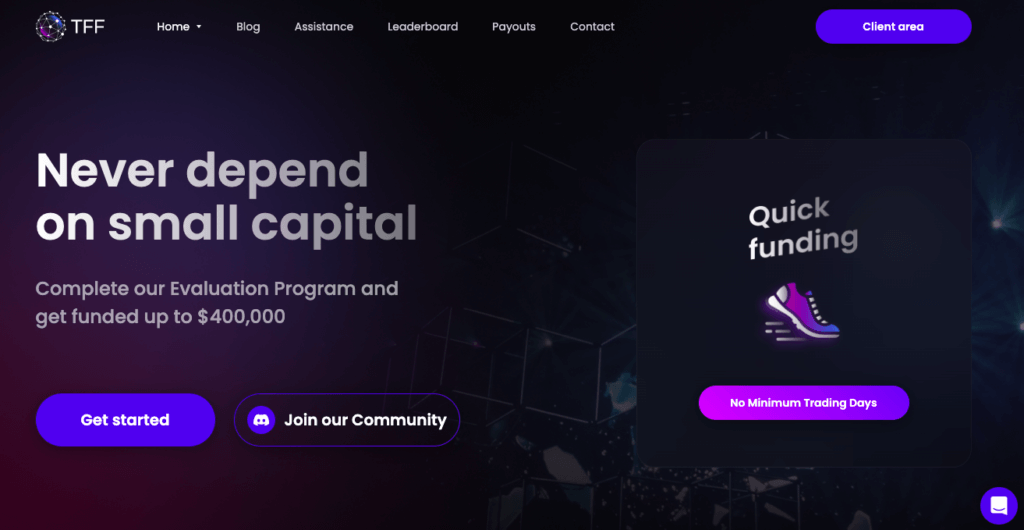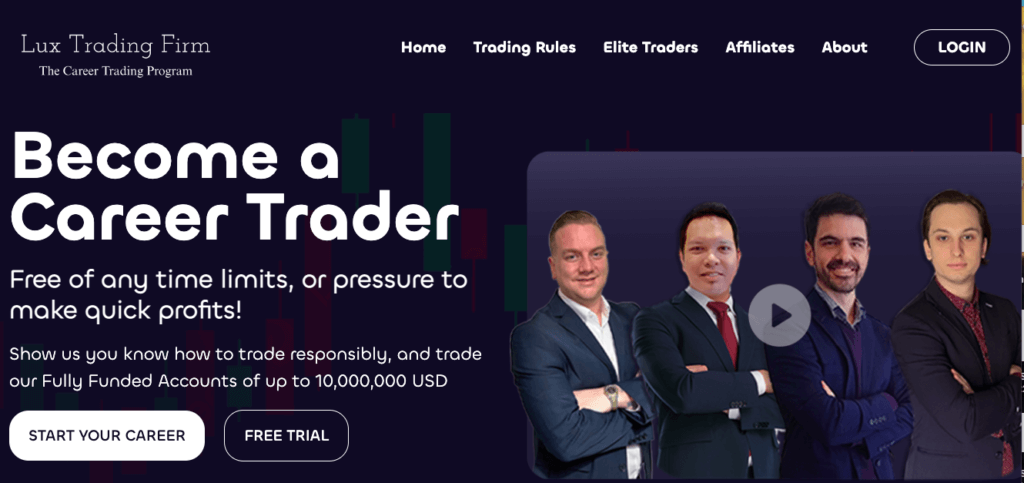For most of Wall Street’s history, proprietary trading was the realm of Ivy Leaguers on the trading desks of the big banks. But the big banks blew it in a big way, causing the 2008 financial crisis and their prop trading desks were regulated out of existence.
Now, a new type of prop trading firm has emerged and they’re willing to fund anyone who can demonstrate that they know how to make money in the market. This is an incredible opportunity for skilled traders.
Recently, some big prop firms like My Forex Funds have collapsed, so I’m changing my rankings and strongly urging you to use only the safest, most trustworthy prop trading firms until further notice.
Table of Contents
Review Summary
Find the best prop trading firm with my comparison chart that provides prices, current discounts, trading rules and the most important account information. These are my three most trusted prop firms.
| BEST REPUTATION | BEST CURRENT PROMO | BEST FOR QUICK FUNDING | |
|---|---|---|---|
| Firm | FTMO | Topstep | The 5%ers |
| Initial Balance /Fees | $10K – €155 $25K – €250 $50K – €345 $100K – €1080 (Refundable upon passing of evaluation) | $50K – $49 $100K – $99 $150K – $149 (per month with current 70% off promo ) | High Stakes $5K – $39 $20K – $165 $60K – $300 $100K – $495 Boot Camp $100K – $95 $250K – $225 Hyper Growth $10K – $260 $20K – $450 $40K – $850 |
| Prop Firm Promo Code or Current Discount | Click for free trial | Click this link for up to 70% off! | Click for 5% discount |
| Trustworthiness/ Safety | Most famous, reputable prop firm in the world Founded 2015 Based in Czech Republic, no fear of CFTC shutdown | 10+ Years in Business “In full compliance with all CFTC and NFA regulations” – Topstep COO Live funded accounts trade real capital on the CME Headquartered in Chicago Board of Trade Building | Funded traders trade real funds Not US based – no fear of CFTC shutdown Different business model from MFF – funded traders trade from 5%ers’ private equity fund |
| Highlights | Currently not accepting new US traders Has paid out more than $180 Million to traders Unlimited trading days Get funded in as few as 8 days Profit target for FTMO Challenge – 10% for Step 1, 5% for Step 2 Up to 90% profit splits Trade forex, stocks, indices, crypto, and more | Keep 100% of your first $10,000 in profits; 90% thereafter Complete one-step evaluation in as few as two trading days Only one rule: Don’t exceed the maximum loss limit Accounts can be reset at anytime More than 5,000 accounts were earned last year alone Offers forex futures + many other CME & CBOT products | No minimum trades or trading days for Hyper Growth accounts Successful traders can reach 100% profit split Trade forex, metals and indices No daily loss limits on many accounts 6% – 10% profit targets depending on account Max leverage 1:100 |
| Swap-Free Accounts | Yes | N/A | No |
| Get Started | Start Trading with FTMO | Start Trading with Topstep | Start Trading with the 5%ers |
| BEST REPUTATION | |
|---|---|
| Firm | FTMO |
| Initial Balance /Fees | $10K – €155 $25K – €250 $50K – €345 $100K – €1080 (Refundable upon passing of evaluation) |
| Prop Firm Promo Code or Current Discount | Click for free trial |
| Trustworthiness/ Safety | Most famous, reputable prop firm in the world Founded 2015 Based in Czech Republic, no fear of CFTC shutdown |
| Highlights | Currently not accepting new US traders Has paid out more than $180 Million to traders Unlimited trading days Get funded in as few as 8 days Profit target for FTMO Challenge – 10% for Step 1, 5% for Step 2 Up to 90% profit splits Trade forex, stocks, indices, crypto, and more |
| Swap-Free Accounts | Yes |
| Get Started | Start Trading with FTMO |
| BEST CURRENT PROMO | |
|---|---|
| Firm | Topstep |
| Initial Balance /Fees | $50K – $49 $100K – $99 $150K – $149 (per month with current 70% off promo ) |
| Prop Firm Promo Code or Current Discount | Click this link for up to 70% off! |
| Trustworthiness/ Safety | 10+ Years in Business “In full compliance with all CFTC and NFA regulations” – Topstep COO Live funded accounts trade real capital on the CME Headquartered in Chicago Board of Trade Building |
| Highlights | Keep 100% of your first $10,000 in profits; 90% thereafter Complete one-step evaluation in as few as two trading days Only one rule: Don’t exceed the maximum loss limit Accounts can be reset at anytime More than 5,000 accounts were earned last year alone Offers forex futures + many other CME & CBOT products |
| Swap-Free Accounts | N/A |
| Get Started | Start Trading with Topstep |
| BEST FOR QUICK FUNDING | |
|---|---|
| Firm | The 5%ers |
| Initial Balance /Fees | High Stakes $5K – $39 $20K – $165 $60K – $300 $100K – $495 Boot Camp $100K – $95 $250K – $225 Hyper Growth $10K – $260 $20K – $450 $40K – $850 |
| Prop Firm Promo Code or Current Discount | Click for 5% discount |
| Trustworthiness/ Safety | Funded traders trade real funds Not US based – no fear of CFTC shutdown Different business model from MFF – funded traders trade from 5%ers’ private equity fund |
| Highlights | No minimum trades or trading days for Hyper Growth accounts Successful traders can reach 100% profit split Trade forex, metals and indices No daily loss limits on many accounts 6% – 10% profit targets depending on account Max leverage 1:100 |
| Swap-Free Accounts | No |
| Get Started | Start Trading with the 5%ers |
My Top Pick: Topstep Futures – 9.4/10 (Best Current Promotion)
Topstep has always had a stellar reputation, phenomenal trader support, and very generous payouts. Topstep is hands down the best prop firm for trading futures, and thanks to a current promotion that offers up to 70% off, they’ve also become one of best bargains in the business.
They’re recent announcement of a one-step evaluation and only one trading rule makes them even more attractive.
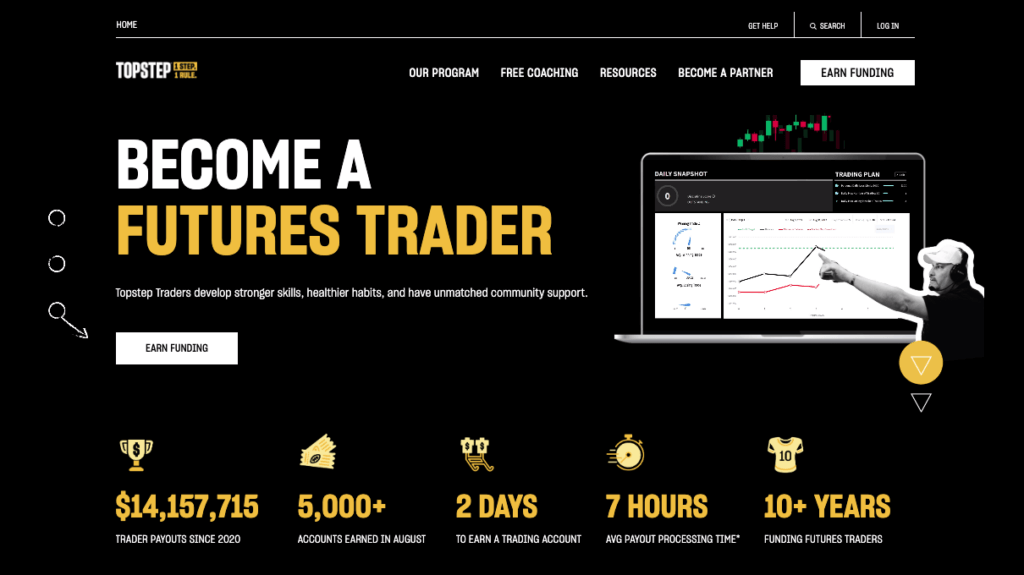
Pros
During their 10 years in the prop trading business, Topstep has become a trader favorite for a number of good reasons. They fund thousands of traders and pay out millions of dollars in trading profits every year.
The principal reason for their popularity, I suspect, is that they are very generous with their profit payouts. Very generous. In fact, you keep 100% of your first $5,000-$10,000 in profits (depending on which account you choose). After you squirrel that away, they’ll still give you 90% of your profits going forward, which is the top payout percentage in the industry.
Topstep has also very recently eliminated their two-step evaluation process. The Trader Combine is now just one step. That means traders opening an account now are possibly just two days away from being funded. Topstep funded over 8,500 accounts last year alone, and by streamlining the evaluation stage, they will fund far more this year. Latest figures had them funding 5,000 traders in August alone.
Traders also benefit from the fact that Topstep gives you unlimited time to hit your profit targets in order to pass the Trader Combine. You can take as much time as you need so long as you don’t hit your loss limit or trailing maximum drawdown. It should be noted that you will continue to pay your monthly fee so long as you’re in the Trader Combine, but once you’re confirmed as a funded trader, those monthly fees go away.
Topstep also has one of the industry’s best educational programs for futures traders. Topstep traders have access to group training sessions led by experienced traders, a digital trading coach known as “Coach T” and an incredible library of blog posts, podcasts, the new live TopstepTV and many other training materials.
As a US-based trader, I also appreciate the fact that Topstep is headquartered in Chicago, so there’s no currency conversions involved, like there is with a lot of other prop firms.
Topstep is one of the best values in the industry, particularly with the current bargain they’re offering my readers. With up to a 70% discount that you can claim by following this link, you can start proving your trading skills in the Combine for just $132/month.I can’t recall a better deal for such a renowned prop firm. It’s an amazing opportunity you shouldn’t pass up.
Cons
Topstep’s new, one-step, one-rule evaluation has made everything a lot simpler, but there is a little confusion about the differences between the Express Funded Account and the Live Funded Account. Luckily, they have one of the best customer service departments in the industry to answer any lingering questions.
I’m a little uncertain about monthly fees rather than a one-time fee. If you complete the Trading Combine two months or less, you’ve made a tremendous deal. If it takes you four or five months to earn a funded account, the fees can add up.
Overall
Topstep is one of the premier prop trading firms in the world, with a proven track record of big payouts, outstanding trader support, and fair trading parameters. At the moment, they’re also a great bargain, so sign up now to take your first step toward a potentially lucrative prop trading career.
#2: The 5%ers – 9.2/10
The 5%ers offers quick funding, quick account scaling and great trader support. They are amongst the world’s most trusted prop firms thanks to their transparency, unique business structure and elite risk management team.
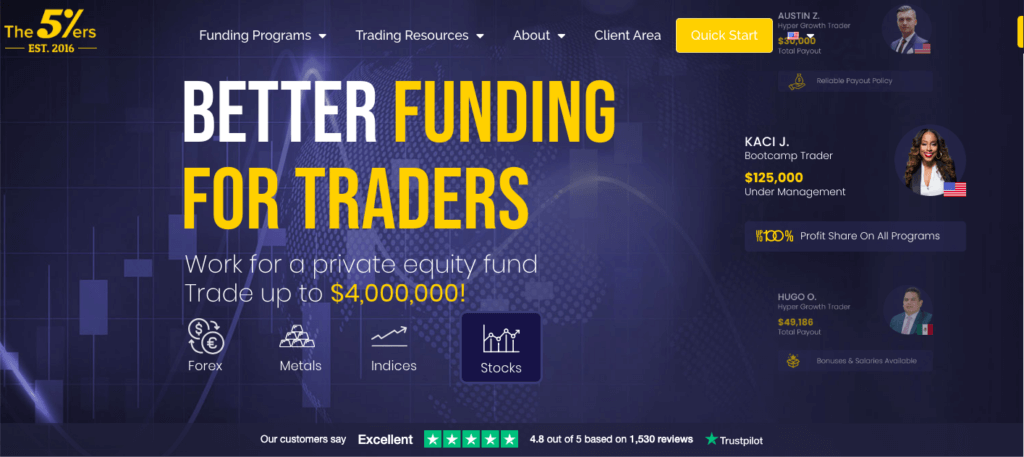
Pros
There’s a lot of reasons to love the 5%ers, but in these uncertain times for prop trading firms, the best reason may be their management team.
The 5%ers is probably the best set up of any forex prop firm to withstand any changing regulations. They have a unique business structure in that they have a private equity pool. Traders who become funded trade money from that pool, and are compensated for that trading as contractors.
At no point does the 5%ers act like a broker or market maker. This well-thought out structure makes them an ideal prop firm in times like these. We don’t know who the CFTC will target next, but we can be pretty damn sure it won’t be the 5%ers.
The 5%ers is also known for having an account that suits any type of trader. Boot-camp is a three-step evaluation program for beginners that comes at a very attractive price point, with easily obtainable 6% profit targets.
The High Stakes account offers traders up to 1:100 leverage, a generous 10% max loss with profit targets set at just 8%. It has a two-step evaluation process, but you can complete both stages in just six days if you hit your target.
Hyper-Growth is an evolution of the 5%ers old instant funding program and allows you to get real funding in just one step, which you can complete without any minimum days or trades. You can then double your capital if you hit profit targets, up to $4 million. Elite traders can even earn a 100% profit split, which is unprecedented in the industry. According to the 5%ers, the Hyper-Growth program has the “highest success rate in the industry.”
One of the reasons for the high success rates at the 5%ers is that many accounts don’t have a daily loss limit, simply a “daily pause.” If you’re having a bad day at the trading desk and hit your daily pause limit, you simply can’t trade any more that day. You don’t lose your account, and you’ll be back at the next day.
The 5%ers is also renowned for their trader assistance, trader community and customer service, which is mentioned in almost every online review you can find. In a pretty short time frame, the 5%ers have built a community of loyal traders who love them for their overall trader support.
A great example as to the links the 5%ers will go to support their traders is their partnership with Dr. Gary Dayton, a psychologist and author who specializes in trader psychology. Over seven sessions, Dr. Dayton will help you tackle perhaps the most difficult aspect of trading. Other prop firms would charge extra for such an invaluable service, but with the 5%ers, it’s free for all their traders.
Cons
Some traders have complained about the stop-loss requirement for every trade, but this only actually applies to Boot Camp accounts, which are designed for traders still working on their risk management. If you can’t deal with stop losses, simply open one of the other two account types.
One potential drawback to the 5%ers is that they have limited assets available for some accounts. For a long time the 5%ers were forex only. They’ve been adding assets, but right now they are still only allowing forex, metals and indices.
If you have any desire to trade other markets, you will need a separate account with a different prop firm.
Overall
The 5%ers are perfectly structured to stick around forever. Plus their scaling plan, profit splits, trader support and educational resources rank amongst the best in the industry. To start a long term trading career with one of the best, sign up with the 5%ers now.
#3 FTMO – 9.0/10
FTMO lets you trade just about any financial instrument out there, and with more than 10,000 traders worldwide, they are probably the most reputable, successful prop trading firm in the world. (UPDATE: As of January 10, 2024, FTMO is not accepting US traders, at least for the time being.)
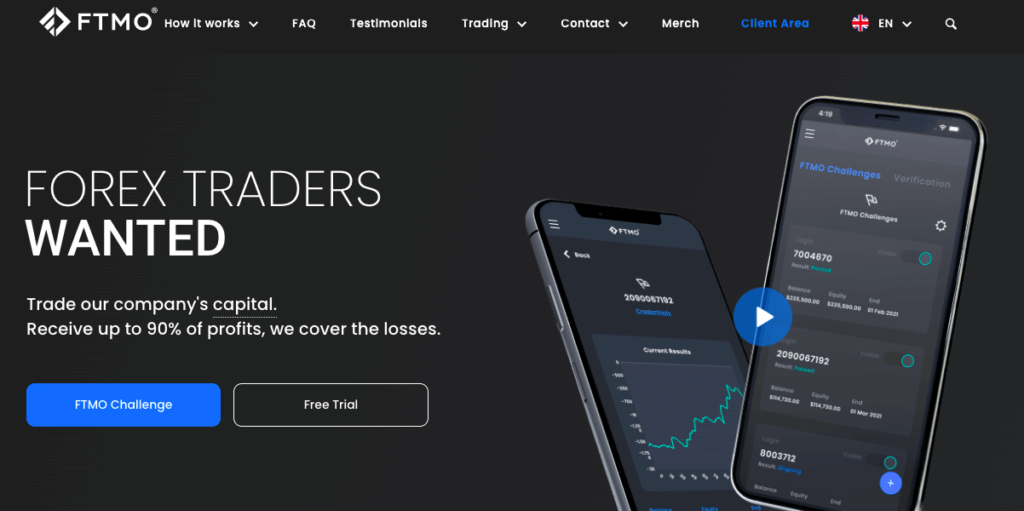
Pros
FTMO has a great reputation for good reason. You won’t find a single complaint about them not paying out on time or making accounting mistakes. You will get every cent that you earn. With some of the bottom feeders in this industry, that is not always the case.
Profit splitting starts at 80% but operates on a sliding scale, meaning that the truly elite traders keep up to 90% of the profits, which is second highest in the industry behind the 5%ers.
They also offer great scaling opportunities. After passing the two-stage evaluation process, which includes the famous FTMO Challenge, traders can have access to up to $400,000. If you generate a 10% net profit or higher over a certain time period, FTMO will incrementally raise your funding to a maximum of $2 million. FTMO knows that it takes money to make money and they fund their traders accordingly.
FTMO also allows its traders access to almost every financial market you can think of. If you’ve mastered a particular market, they’ll let you trade it, from forex to futures to metals to equities. Many prop trading firms are only focused on very particular markets, but FTMO gives you the freedom to trade what you want.
They also have one of the most professional trading platforms in the industry and excellent educational resources, mostly due to their investment in new trade tracking technology. FTMO traders are given access to a series of apps that track your trading tendencies and offer real-time feedback.
One of the things that best exemplifies FTMO’s commitment to helping their traders is that they employ trained psychologists. The psychological aspects of trading are well known, and yet FTMO is one of the few prop firms that actually offers support in this critical area.
Evaluation parameters are pretty standard, although they’ve made a recent concession to make things easier. Max losses are $1,000 on a $10,000 account and your profit targets are 10% over 10 trading days in Step 1, but they’ve cut the Step 2 target to 5%, which obviously takes a lot of the pressure off.
Of all the reputable prop firms, FTMO comes in as one of the most affordable. Current prices start at just €155 for a $10,000 funded account. This is very cheap, and this one-time fee is fully refunded should you pass the two-step evaluation process.
Cons
In January, 2024, FTMO announced that they were — at least temporarily — not accepting new US traders. They were pretty vague as to why, citing only “specific conditions in the market segment there.” Speculation has run rampant, but my best guess is that they are awaiting the outcome of the case brought against My Forex Funds by the CFTC.
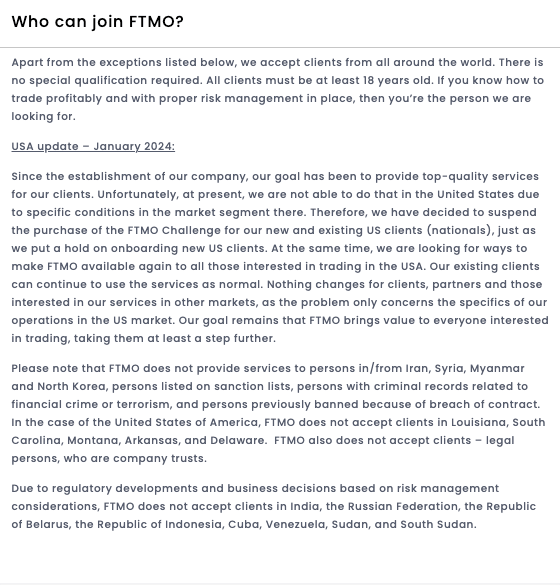
Some traders are turned off by the fact that FTMO doesn’t actually let you trade real money, even if you earn a funded account. Personally, this doesn’t make such a big difference to me. I’m still getting paid out on my virtual trades as if they were real, so what of it? I don’t really care if FTMO is making money off my strategy or not, so long as I am.
Using “dummy” accounts does, however, bring up the question of how dedicated FTMO is to helping their traders. If they don’t actually profit when their traders profit, what’s their incentive to guide you along? I’d argue, however, that the massive investment FTMO has made to develop their training programs and trade tracking apps proves their dedication to helping traders succeed.
Overall
FTMO is one of the most popular, transparent, and supportive proprietary trading firms you’re going to find and their profit splits are second to none. There’s never been a better time to start your evaluation and eventually join the thousands of traders who have made great money trading with FTMO.
#4 True Forex Funds
True Forex Funds is currently resolving broker issues and is not accepting new clients. I’ll update this once they’ve successfully changed brokers.
Pros
True Forex Funds has only been in the game for a few years now, but they’ve already paid out $62 million to profitable traders, according to their website. They are good example of how quickly positive word of mouth can spread in the prop trading community.
The thing that stands out the most with True Forex Funds is the simplicity of their rules. They don’t require stop-losses, you’re allowed to use EA’s, you can hold trades overnight or over weekends, and news trading is allowed. If you love the capital prop trading provides but hate all the rules, True Forex Funds is a great choice.
They also don’t try to trip you up with any complicated drawdown calculations. You simply need to keep your balance above 90% of your initial balance, and 95% of your daily balance. They also offer very obtainable profit targets, starting at just 8% for Phase 1 of their evaluation and 5% for Phase 2. That’s a bit better than industry standard.
TFF also comes in on the cheaper side, often 15% less than FTMO. TFF doesn’t offer a whole lot of promos, however, so when you spot a True Forex Fund promo code on my discounts page, jump at it immediately.
Although “forex” is obviously in their name, TFF has really expanded their list of tradable assets. Through CFDs you can now trade more than 25 cryptocurrencies, in addition to shares from 25 companies, indices, metals, and, or course, 40 currency pairs.
Many prop traders turned to TFF when MFF went down, and I don’t think it was because of the similar acronyms. TFF offers a similar product to MFF, but since they are not based in the US, they aren’t subject to the whims of the CFTC.
When payment processor Deel stopped issuing payouts on behalf of prop firms (also thanks to the MFF mess), True Forex Funds was very quick to pivot to other payment processors. Thanks to their quick action, TFF had far less payout issues than other firms. Obviously that was great for traders, but it also proved that TFF management has a handle on the rapidly changing prop trading firm landscape.
Cons
True Forex Funds had some uncharacteristic issues starting in late January 2024. I began hearing a number of complaints. Soon thereafter, they were dropped by their broker and have been working on finding a replacement ever since. They are not accepting new clients until these issues have been resolved.
It is not something I have personally experienced, but the knock on TFF has always been that they experience more slippage than most. Yes there’s slippage, as there is with all prop firms, but I’ve never seen anything outrageous. But despite my lack of first hand knowledge, I’ve heard some complaints about this from traders I trust, so I think it’s worth mentioning.
TFF also uses CFDs exclusively to trade forex, crypto and all the other assets they offer. There is nothing wrong with CFDs, but you have to understand the product before you begin trading. Don’t sign up with TFF if you don’t understand the basics of how to trade CFDs.
I’m also a little disappointed in TFF’s trading community. I was happy when they reopened their Discord channel, but is far less active than what you’ll find with other prop firms. TFF’s educational resources also lag a bit behind the competition.
We’ve seen two years of verified payouts from TFF and they’re obviously legit, and I have alot of faith in them, but they still feel a little bit like the new kid on the block to me. See one of the firms above if you want a prop firm that has withstood the test of time.
Overall
I love True Forex Funds for their simple rules and quick payouts. If they can solve their broker issues, they are a good forex prop option. If you understand CFDs and want your capital in a hurry, sign up with TFF today.
#5: Fidelcrest – 8.9/10 (Best For Big Accounts)
Fidelcrest is best known for their flash sales, in which they often offer 2×1 accounts. That’s a great deal, but when it is not offered, Fidelcrest is a pretty average prop trading firm with few educational resources and so-so trading conditions.
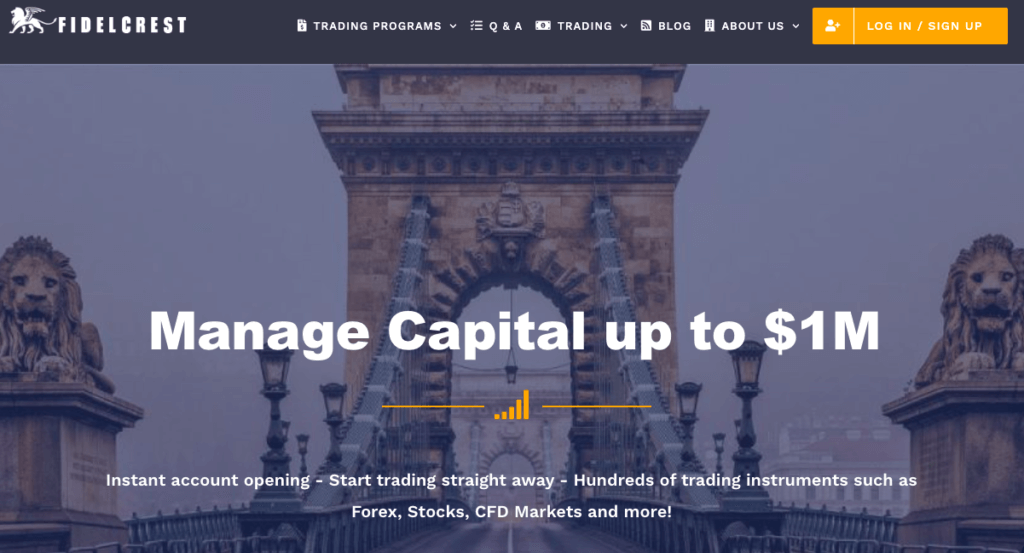
Pros
The biggest advantage of Fidelcrest is their frequently run 2×1 promo. Once a month or so, they’ll offer two accounts for the price of one, which even applies to their million dollar accounts.
It works like this: Once you pass Phase 1 of the two-phase evaluation, you get a second account for free. That’s a pretty amazing bonus for passing just one stage. WIth their current prices, that means you could have two $1 million accounts for just €2999.
Along with FTMO, Fidelcrest offers some of the highest potential profit split in the business, but unlike FTMO, you can trade real capital with Fidelcrest. During your two phases of evaluation, you’ll be trading with demo accounts, but funded traders have access to real capital.
Fidelcrest is also on the cutting edge in terms of tradable assets. I have yet to find a prop trading firm that offers more options for trading crypto, so if that’s your market of choice, look no further. Last time I counted, you could trade 19 crypto pairs. You can also trade forex, commodities, indices, and shares.
There’s been a recent trend amongst prop firms of offering “add-ons.” Add-ons are extra features you can add on to your account for a fee. No one has embraced this trend more than Fidelcrest. Fidelcrest currently offers five different add-ons. For an extra fee you can get unlimited trading days, double leverage, insurance and more. So if you like customizing your account, Fidelcrest is a great choice for you.
Fidelcrest also offers more account options than anybody. Regardless of your risk tolerance, trading strategy, experience level, or budget, you will find the perfect account for your needs. Pro Accounts offer the highest amount of capital, Aggressive Accounts offer the best payouts, and Micro Accounts offer the lowest profit objectives and the lowest prices. Accounts range in size from $10,000 in capital, all the way up to $1 million accounts. The options are endless.
Cons
For years, I complained about Fidelcrest for one reason — they actually made the second stage of their evaluation process harder than the first. They weren’t sneaky about it, but since they were the only prop firm that tightened trading parameters for Phase 2, it felt dishonest.
They’ve changed that rule, but haven’t really shaken the reputation that they don’t have trader’s best interests in mind.
I also don’t like the fact that Fidelcrest calculates your max loss based on your highest recorded balance. So if you get off to a good start and are up 7% but suffer a few bad days and fall to +1%, you would fail the Verification because you’ve lost more than 5% off your high balance. So with Fidelcrest, you could possibly fail even if your account is still in the green.
Fidelcrest is very upfront about this calculation, but it still seems to take some traders by surprise. As always, make sure you understand all trading parameters before you sign up with a prop trading firm.
I also don’t like that so many features cost extra. Almost every prop firm in the world now offers traders unlimited trading days. At Fidelcrest you have to pay extra to extend your trading time.
Overall
Fidelcrest is a decent option if you want to trade crypto or other assets that aren’t offered by other prop firms, and if you can take advantage of their 2×1 account promos. You can check my prop firm promos page to check if Fidelcrest is currently making their special offer. If they aren’t, there’s not a lot of reasons to choose them.
#6: The Funded Trader – 8.8/10
The Funded Trader had a moment were they seemed destined to become one of the most popular prop firms in the world due to their verified payouts, obtainable profit targets, generous drawdown limits, high leverage, and great prices.
Concerns about their similarities to My Forex Funds, which was closed by the CFTC, have traders thinking twice about the Funded Trader however.
They still have some great promos though: Click for 10% off plus a 110% refund with code NYEKINGDOM.
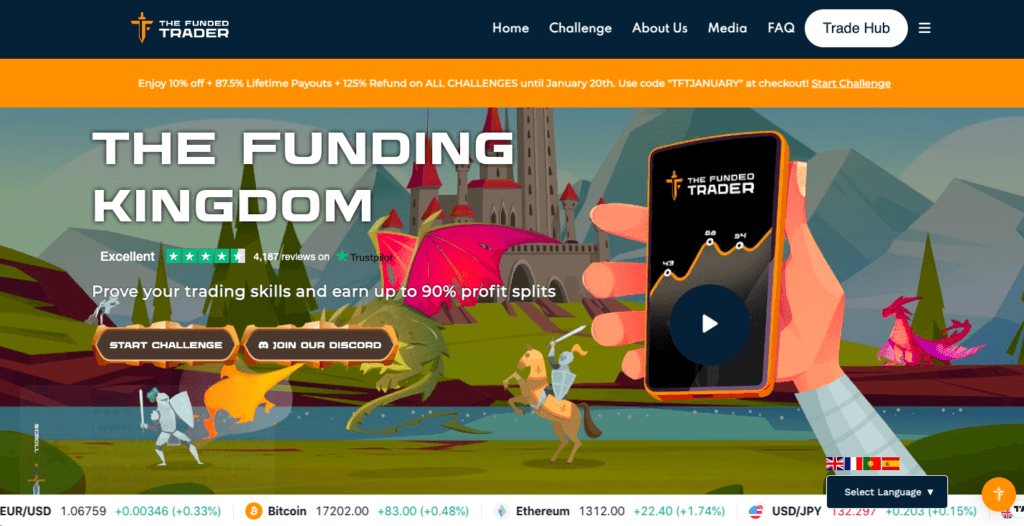
Pros
There’s a lot to like about one of the most popular new prop firms. We’ll start with the price points, which are amongst the best in the industry. For a $50K account, a one-time $315 fee, which is fully refunded if you pass the evaluations, is about as good as it gets.
For such a great price, you’d expect some concessions in other areas, but the Funded Trader matches up with FTMO and other industry leaders in terms of payout percentage (80%–90%), scaling opportunities (up to $1.5 million), and profit targets (10% for the first stage, 5% for the second).
In other key categories, the Funded Trader actually bests the competition. The max loss of 12% is very generous, and they don’t skimp on the daily max loss (6%) either. Those are both a tick or two better than industry standard, and in such volatile times, that can be the difference between failing an evaluation and living to trade another day.
The Funded Trader also has only five minimum trading days for the evaluation stages in its Standard account and offers a Rapid account with no minimum trading days. Meet your profit targets and you could be a funded trader within a matter of days.
If you are a more conservative trader, the Funded Trader gives you a little more time to hit your profit targets. For even the most patient traders, 35 days for the first stage and 60 for the second should be ample time.
The Funded Trader also stands out in terms of leverage. If you choose a Rapid account, your account leverage is a robust 100:1 when trading forex. It’s even higher with the Standard account, which boasts 200:1 leverage. Even funded traders enjoy 100:1 leverage. Profit targets are obviously much easier to hit when you have so much buying power.
And while forex is the focus of most Funded Trader clients, you can also trade crypto, indices, and some commodities, depending on your trading platform.
In addition to all the above advantages, traders also love Funded Trader’s lax rules regarding trading style. Basically, anything goes unless you’re trying to take advantage of the demo environment. For instance, if you try to take advantage of a demo server error, your account will be forfeited. You can even hold trades overnight or over weekends, unless you’re trading shares. Trade copiers are permitted so long as your Funded Trader is the master account.
Cons
It’s probably not fair to the Funded Trader to count the whims of the CFTC against them, but the threat of a CFTC shutdown is hanging heavily over their heads. This is all speculation of course, but if you read the complaint against My Forex Funds, it seems like the same document could have been filed against the Funded Trader.
The Funded Trader is based in the US, offers leveraged products (up to 1:200), exclusively uses a demo trading environment, and is a high profile prop firm. Add it all up, and I’d think that makes them a pretty enticing target for the CFTC. We’ll see. Hopefully the CFTC or another US financial regulator will outline some solid rules for prop firms, and the Funded Traders and others can avoid any sort of unpleasant surprise shutdowns.
I don’t like to take personal shots, but I also don’t trust CEO Angelo Ciaramello. He’s been a larger than life presence in the prop trading community for a while now, for better or worse. He’s remarkably transparent about some things, but I lost a lot of faith in him with the demise of Leveled Up Society. Ciaramello and his partners let their differences shutter the business for months on end as Ciarmello left the business all together. A lot of traders were caught up in this power struggle and lost access to accounts.
Beyond that, I’ve heard a lot of complaints lately about the Funded Trader shutting down accounts under flimsy pretexts. It is nothing I’ve personally experienced, but join any prop trading firm channel on Discord or any prop firm Facebook group and you’ll read some pretty outrageous accusations.
Overall
It seems to me that the founders of the Funded Trader took a good hard look at FTMO and decided to make something a little bit better and a little bit cheaper. In some ways they succeeded, but concerns that the CFTC might be knocking at the Funded Trader’s door next have me choosing FTMO at this time.
#7 Lux Trading
Lux Trading is an old-school prop trading firm. They are looking for dedicated, experienced traders and reward the best of them with a substantial amount of capital, and I mean substantial. If you prove yourself to be a consistent, profitable trader, you can scale your account all the way up to $10 million with Lux Trading. That’s the big leagues, for sure.
Of course they don’t just hand out $10 million to anyone—Lux takes a good long look at its traders before funding them, which is one of the reasons why I don’t rank Lux higher. In order to become a funded trader, you have to actively trade for a total of 49 days. That’s a much longer evaluation period than most of the other firms on my list.
On the flipside, they give you as long as you need to hit your profit targets, so you’re not forced into panic trades by an impending deadline.
Another reason Lux is near the bottom is that they only pay out 75%. That’s 5-15% less than you’ll find anywhere else. However, Lux pays a lot more individual attention to its traders and offers a lot of guidance, especially in the area of risk management. That alone may be worth the extra 5-15%.
Lux also has pretty tight trading parameters, but that should come as no surprise. The bottom line is this: Lux wants professional traders with a long-term, risk-averse perspective who know what they are doing and are willing to put in their dues. If that’s you, you can sign up with Lux here—you just might be on your way to managing $10 million.
#8: SurgeTrader – 8.3/10
SurgeTrader is a relative newcomer to the prop trading space, but has garnered some attention thanks to their relatively simple trading rules, one-stage evaluation and quick funding. Higher prices and some recent SEC allegations about related companies keep them from being higher up on my list.
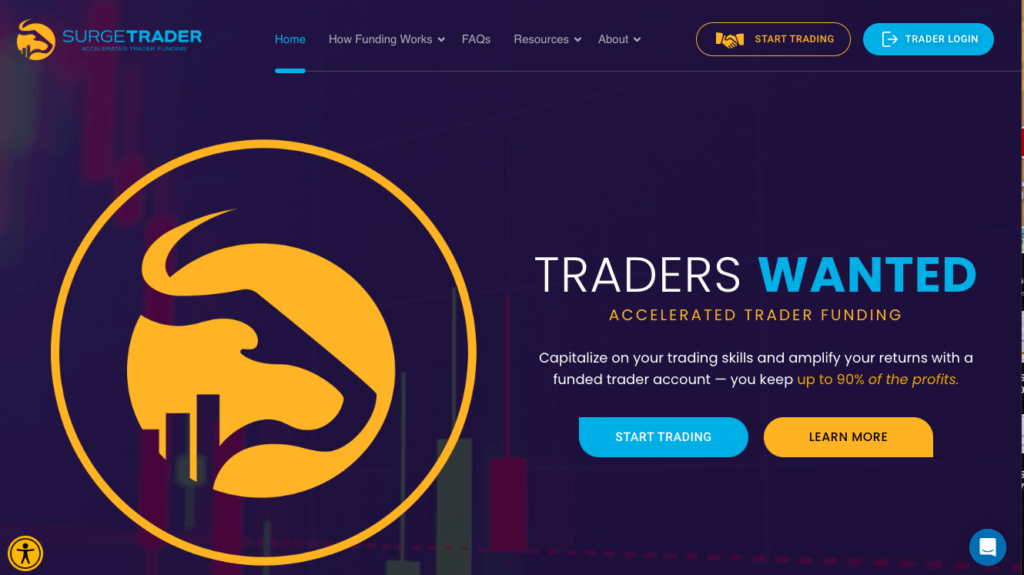
Pros
One of the main reasons SurgeTrader made my list is that they are extremely quick to fund traders. They do not instantly fund traders, but they have no minimum trading days with a one-phase evaluation. Whenever you hit your 10% profit target, you’re funded, and you can see your new capital within a matter of hours.
The biggest drawback of prop firms that offer instant funding is that your profit share is usually lower, but SurgeTrader offers 75-90% and will fund you almost as fast.
SurgeTrader also offers Lightning accounts — which give you one week to hit a 5% profit target, and a standard two-phase evaluation.
SurgeTrader gets high marks in terms of customer service and has a great reputation for responding to traders’ concerns. I’ve never waited more than a few minutes for a response from them, although I honestly haven’t had to use customer service that often.
As far as rules go, SurgeTrader keeps it pretty simple, which is a big plus. SurgeTrader breaks their rules down in two categories: hard rules and soft rules. The hard rules are the drawdown limits. Violate those and you’re done. There’s also three soft rules: you must include a stop-loss with every trade, you must close all positions over the weekend, and you can only have a certain number of lots open, relative to the size of your account. If you violate one of the soft rules, your position is merely closed, but your account is open.
SurgeTrader also offers a lot of support in the form of blog posts and educational opportunities, which makes them a good option for traders just learning the ropes. They also allow access to a lot of different markets, and are very permitting when it comes to trading styles.
Cons
The biggest drawback to SurgeTrader is the cost. For the smaller account sizes, SurgeTrader is roughly 20-25% more expensive than the Funded Trader. And for larger account sizes like the million dollar account, Fidelcrest is up to 50% cheaper.
That said, I think you get more personal service at SurgeTrader than you do at the Funded Trader, and you only have one audition with SurgeTrader compared to two with Fidelcrest and most other prop firms. Whether or not the extra cost is worth these advantages, is up to you.
I also mentioned above that the payout from SurgeTrader is 75-90%. Why the variance? With SurgeTrader you can make an “add-on” purchase to increase your payout to 90%. For example, if you purchase a $50K audition the add-on fee to receive a 90% payout is 20% of the purchase price, which is an extra $80 at current prices.
I’m also not a big fan of trailing drawdowns, although SurgeTrader’s calculation of trailing drawdown is pretty trader-friendly compared to other prop firms. Once you’ve profited more than 5%, the trailing drawdown is removed and your loss limit is simply your starting balance.
Finally, the SEC announced that Brent Seaman, husband of SurgeTrader’s CEO Jana Seaman, had been charged with operating a $35 million ponzi scheme. So far there seems to be no effect on SurgeTrader’s business, but I’m waiting to see how it all shakes out.
There’s also that pesky CFTC to consider. SurgeTrader might avoid their wrath for the time being simply because they’re a smaller firm, but I have to think they’ll be taking a good hard look at SurgeTrader before too long.
Overall
If you’re willing to pay a premium price, there are a lot of advantages to trading with SurgeTrader. You’ll be funded fast, receive good trader support and won’t spend a lot of time puzzling over complicated rules.
Prop Trading FAQs
For further information, check out my introduction to prop trading article, but here’s some basic info on proprietary trading:
What is Proprietary Trading?
Proprietary trading is when a firm uses its own money to trade any sort of financial instrument in order to make a profit.
Today, proprietary trading is mainly conducted by two types of companies. Some prop trading firms, like the ones I’ve ranked above, allow anyone to trade with their capital so long as you follow the rules. You have to pay a fee, agree to trade according to the firm’s strict parameters, and (in some cases) pass a trader evaluation in order to become a funded trader.
If you sign up with this type of proprietary trading company and follow the rules, they’ll give you up to $2 million to invest. You can split any profits you make, keeping as much as 90% and you won’t be responsible for any losses. If you violate the trading terms or lose too much money, the prop firm will cancel your account.
Examples of these firms are those above, plus many others including My Forex Funds, SurgeTrader, Lux Trading, Audacity Capital, and City Traders Imperium.
The second type of proprietary trading firm is the Wall Street version. These are the prop trading companies that hire math prodigies who graduated from Yale at the age of 16. If you are lucky enough to get hired as a trader by one of these companies, you’ll get a spot on a physical trading desk, and have an actual salary, plus benefits. You’ll also get a percentage of your trading profits in the form of a bonus.
Examples of this second type of proprietary trading company are Jane Street Capital, Hudson River Trading, Optiver, 3Red Partners, Jump Trading, Virtu Financial, and many more.
Who much do prop traders make?
More than most professions, prop traders compensation is based on their performance. If you work for one of the Wall Street-style prop firms, you’ll likely make more than $100,000 in a base salary, with a potentially significant bonus based on a percentage of your trading profits.
Prop traders who use funded trader programs only make money if they profit. If you sign up with FTMO, for example, once you pass their evaluation stage, you will become a funded trader. As a funded trader, you keep up to 90% of your profits. If you don’t profit, you won’t see a dime.
Is proprietary trading legal?
Yes, it is. There is some confusion about this because of the Volcker Rule, which was passed after the 2008 financial crisis. The Volcker Rule outlawed banks from having prop trading desks. The intention was to prevent the banks from making overly risky trades with depositors money. So the ban on proprietary trading only applies to banks.
Is prop trading a scam?
No. It is perfectly legit. Depending on the market, it can be quite difficult to make money as a prop trader, but it is very possible. Good traders can pass an evaluation, invest a prop firm’s capital and split the profits. There are some prop trading firms that make it harder for their traders to succeed than others, however, so do your homework before signing up with any proprietary trading firm.
Do prop firms have promo codes or special offers?
Yes, prop firms offer frequent promotions! Some firms such as Topstep offer special promos to my readers (15% off!), which you can access at any time with this link. Other prop firms such as Fidelcrest and The Funded Trader offer occasional deals for a limited time, which I publish at the top of this article. I always keep the prop firm promos up to date, so check back often.
Quick tip: In general you can find the best prop firm promos during slower trading periods such as around the holidays. Even FTMO, which almost never offers discounts, usually has great offers in December.
Methodology: How to choose the best proprietary trading firms
Choosing the right prop trading company will give you the best chance to maximize your trading profits. Choosing the wrong one could rob you of a lot of time and money. It’s not a decision to be taken lightly, so I want to be as transparent as possible about how I made my rankings.
I began with a list of prop firms that I compiled from my own experience trading, recommendations of friends and traders in my network as well as a google search. There seems to be new prop firms popping up every month, but it was important to me that I only listed firms with a proven track record.
Once I had compiled my list of candidates, I came up with the above rankings by analyzing each firm and awarding points according to the following seven factors:
Factor 1: Profit splits
This is pretty self-explanatory. I awarded the most points to the firms that offered the highest profit splits. Obviously this is a critical category. It is very difficult to consistently make profits as a trader, especially when you’re bound to the rules set up by your prop firm. If you are up to the challenge and turn a profit, obviously you should reap the lion share of the rewards.
I have no problem giving the prop firm their cut. They put up the cash, they assume much of the risk, so they deserve a percentage. But you’re the one doing all the work, sweating through all the tough decisions, and consistently beating the market. You deserve the highest possible profit percentage.
Factor 2: Scaling opportunities
This is another pretty simple category. Most prop firms allow successful traders to trade progressively more capital so long as they continue to meet profit targets. The best, most consistent traders may eventually be entrusted with millions of dollars of a prop firm’s capital.
You’ll see these best-case-scenario figures splashed across every prop firm’s website. “Trade up to $2 million!” This can be misleading, however, as some firms make it nearly impossible to make it to the high water mark.
So when I awarded points in this category, I looked at not only that top figure, but also at how hard the proprietary trading firms make it to get there.
Many firms also bump up their profit splits if you can meet your profit targets, so I also took that into account.
Factor 3: Trading parameters
This is a very important category that many rookie traders don’t look at closely enough when they sign up with their prop firm.
All prop firms control how much risk their traders can take on. This makes perfect sense, of course, since they are entrusting you with their capital.
Prop firms use a number of different tools to limit how much risk you take on. Some don’t allow you to keep positions open overnight or over the weekend. Some don’t allow you to trade news releases, so you are limited when unemployment figures or other key economic data is released. Most employ daily loss limits and overall loss limits or some type of draw-down limits.
If that’s not enough, some prop firms even limit what type of trading strategies you can use.
As I said, prop firms are entitled to limit how much risk you take. It is their money, after all. However, some firms take this too far. As a trader, you have to be able to assume some risk, or you’ll never make a dime.
When awarding points, I rewarded the firms that gave their traders the most freedom by enforcing the fewest restrictions.
I also looked at profit targets for this category, although most proprietary trading firms fall in the 8-10% range, so there’s not a lot of variance. Obviously the lower the profit targets, the easier it will make your life as a trader. In addition to less stress, it will be easier to pass your evaluation period or graduate to higher account levels.
Factor 4: Affordability / Value
I’m amazed at how expensive some prop trading firms are. Some of them charge so much, it makes way more sense to just start trading the money you’d have to pay as fees rather than forking it over to a firm.
I’m also not a big fan of monthly fees. Some of you may prefer that payment model, but I’d rather pay my dues upfront and not worry about it again.
I rewarded prop firms with low price points, but I also looked at what each firm offered with their funded account program. A really cheap prop trading firm that doesn’t offer great trading platforms or good customer support isn’t something I’m going to recommend. I also want to see some bang for your buck.
Factor 5: Tradable assets
I’m a firm believer in finding one niche in the markets, becoming an expert and just trading within that niche. Most of the successful traders I know have done exactly that. However, I still prefer prop trading firms that offer a lot of options when it comes to tradable assets.
Even within certain asset classes, you still need to be aware of exactly which financial instruments you are allowed to trade. For example, some forex prop firms only allow you to trade a limited number of currency pairs, which obviously limits your trading options.
I also like a prop firm that provides a lot of asset options because you never know what your trading future might bring. Your current trading strategy might not be viable in a few years. I don’t want to have to start all over with a new prop trading firm because I had to change strategies.
Factor 6: Educational Resources
If you are already an experienced trader and are simply looking for capital, you may not place too much value in a prop firm’s available educational resources. I get that. But I’d argue two things.
First, with the way financial markets are evolving so quickly these days, it is imperative even for the most seasoned traders to perpetually continue their education. Crypto is a great example. No one knew what this was just a few years ago, but the traders who figured it out early and learned the market first made fortunes. Never stop learning.
Secondly, I think there is a direct correlation between the quality of a proprietary trading firm and the quality of its education program. The best prop trading firms who want their traders to succeed make investments in the ongoing education of their traders. Those that don’t… don’t.
A really good prop firm wants the smartest, most educated traders in the world trading their capital. They will make the necessary investments to make sure that’s what they have.
Factor 7: Customer service
Not something a lot of traders think about, but this is also very important when judging a prop trading firm. Like educational resources, how much a firm invests in its customer service department is a really good indicator of how much they value you, the trader.
Also, prop trading comes with its own set of rules that are unique in the trading world. There are times when even the best traders need some help. With markets moving as fast as they do, it’s critical that you get that sound guidance as quickly as possible.
Top proprietary trading firms have invested in a knowledgeable, helpful, courteous support staff that will be there to guide you whenever you need them.
Conclusion
You have to be very careful when choosing a proprietary trading company. Prop firms come in all shapes and sizes and there’s a lot of them out there that don’t have traders’ best interests at heart.
I truly hope this guide helps you find the right prop trading firm for you. A good proprietary trading firm can give you the capital boost you need to make real money as a trader. That’s my goal for all of you who have decided to go the prop trading route.
If you’re trading with a firm that you love and it isn’t on my list, please let me know here. Also please reach out if you’ve had a bad experience with one of the above firms. I will update my rankings accordingly.
Trading always seems like a me vs you, zero sum game, but it’s not. By exchanging information and learning from our collective experience, we can all help each other along on our journey towards true financial freedom.
If you’re ready for the next step and want to join the prop firm that I think will give you the best chance to become a successful prop trader, sign up with Topstep today.
Further Reading
Full reviews of prop trading firms: FTMO, The 5%ers, Topstep, BluFx, Fidelcrest, and Lux Trading.

